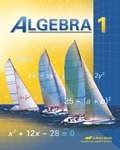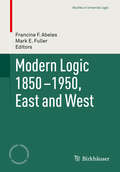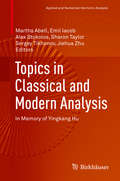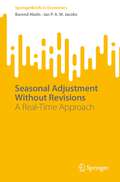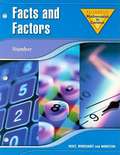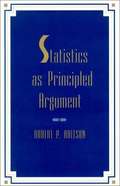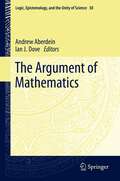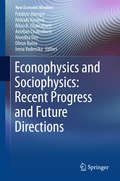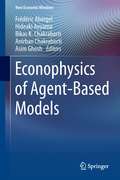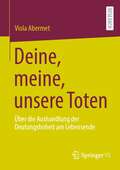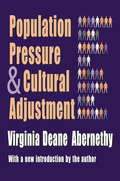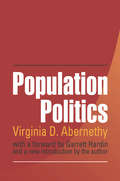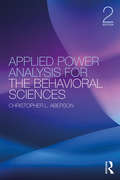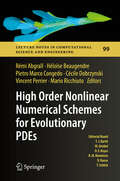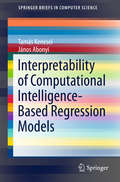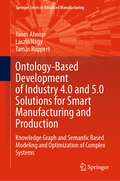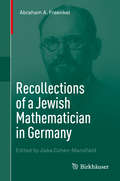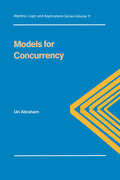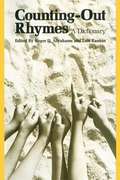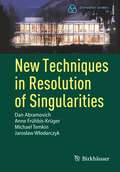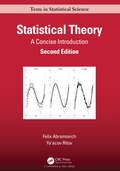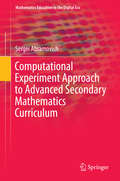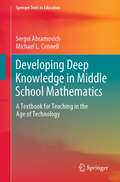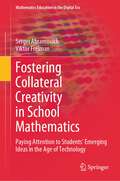- Table View
- List View
Algebra 1
by AbekaAlgebra 1 is a practical textbook with many features to make your study of algebra interesting and successful.
Modern Logic 1850-1950, East and West
by Francine F. Abeles Mark E. FullerThis book presents diverse topics in mathematical logic such as proof theory, meta-mathematics, and applications of logic to mathematical structures. The collection spans the first 100 years of modern logic and is dedicated to the memory of Irving Anellis, founder of the journal 'Modern Logic', whose academic work was essential in promoting the algebraic tradition of logic, as represented by Charles Sanders Peirce. Anellis's association with the Russian logic community introduced their school of logic to a wider audience in the USA, Canada and Western Europe. In addition, the collection takes a historical perspective on proof theory and the development of logic and mathematics in Eastern Logic, the Soviet Union and Russia. The book will be of interest to historians and philosophers in logic and mathematics, and the more specialized papers will also appeal to mathematicians and logicians.
Topics in Classical and Modern Analysis: In Memory of Yingkang Hu (Applied and Numerical Harmonic Analysis)
by Martha Abell Emil Iacob Alex Stokolos Sharon Taylor Sergey Tikhonov Jiehua ZhuDifferent aspects of harmonic analysis, complex analysis, sampling theory, approximation theory and related topics are covered in this volume. The topics included are Fourier analysis, Padè approximation, dynamical systems and difference operators, splines, Christoffel functions, best approximation, discrepancy theory and Jackson-type theorems of approximation. The articles of this collection were originated from the International Conference in Approximation Theory, held in Savannah, GA in 2017, and organized by the editors of this volume.
Seasonal Adjustment Without Revisions: A Real-Time Approach (SpringerBriefs in Economics)
by Barend Abeln Jan P. JacobsSeasonality in economic time series can "obscure" movements of other components in a series that are operationally more important for economic and econometric analyses. In practice, one often prefers to work with seasonally adjusted data to assess the current state of the economy and its future course. This book presents a seasonal adjustment program called CAMPLET, an acronym of its tuning parameters, which consists of a simple adaptive procedure to extract the seasonal and the non-seasonal component from an observed series. Once this process is carried out, there will be no need to revise these components at a later stage when new observations become available. The authors describe the main features of CAMPLET, evaluate the outcomes of CAMPLET and X-13ARIMA-SEATS in a controlled simulation framework using a variety of data generating processes, and illustrate CAMPLET and X-13ARIMA-SEATS with three time series: US non-farm payroll employment, operational income of Ahold and real GDP in the Netherlands. Furthermore they show how CAMPLET performs under the COVID-19 crisis, and its attractiveness in dealing with daily data. This book appeals to scholars and students of econometrics and statistics, interested in the application of statistical methods for empirical economic modeling.
Facts and Factors (Mathematics in Context)
by Meike Abels Jan De Lange Margaret A. PliggeThe numbers we use today are widely used by people all over the world. This might surprise you since there are about 190 independent countries in the world, speaking over 5,000 different languages! This was not always the case. In the unit Facts and Factors, you will investigate how ancient civilizations wrote numbers and performed number computations.
Statistics as Principled Argument
by Robert P. AbelsonIn this illuminating volume, Robert P. Abelson delves into the too-often dismissed problems of interpreting quantitative data and then presenting them in the context of a coherent story about one's research. Unlike too many books on statistics, this is a remarkably engaging read, filled with fascinating real-life (and real-research) examples rather than with recipes for analysis. It will be of true interest and lasting value to beginning graduate students and seasoned researchers alike. The focus of the book is that the purpose of statistics is to organize a useful argument from quantitative evidence, using a form of principled rhetoric. Five criteria, described by the acronym MAGIC (magnitude, articulation, generality, interestingness, and credibility) are proposed as crucial features of a persuasive, principled argument. Particular statistical methods are discussed, with minimum use of formulas and heavy data sets. The ideas throughout the book revolve around elementary probability theory, tests, and simple issues of research design. It is therefore assumed that the reader has already had some access to elementary statistics. Many examples are included to explain the connection of statistics to substantive claims about real phenomena.
The Argument of Mathematics
by Andrew Aberdein Ian J DoveWritten by experts in the field, this volume presents a comprehensive investigation into the relationship between argumentation theory and the philosophy of mathematical practice. Argumentation theory studies reasoning and argument, and especially those aspects not addressed, or not addressed well, by formal deduction. The philosophy of mathematical practice diverges from mainstream philosophy of mathematics in the emphasis it places on what the majority of working mathematicians actually do, rather than on mathematical foundations. The book begins by first challenging the assumption that there is no role for informal logic in mathematics. Next, it details the usefulness of argumentation theory in the understanding of mathematical practice, offering an impressively diverse set of examples, covering the history of mathematics, mathematics education and, perhaps surprisingly, formal proof verification. From there, the book demonstrates that mathematics also offers a valuable testbed for argumentation theory. Coverage concludes by defending attention to mathematical argumentation as the basis for new perspectives on the philosophy of mathematics.
Econophysics and Sociophysics: Recent Progress and Future Directions
by Frédéric Abergel Hideaki Aoyama Bikas K. Chakrabarti Anirban Chakraborti Nivedita Deo Dhruv Raina Irena VodenskaThis book presents the proceedings from ECONOPHYS-2015,an international workshop held in New Delhi, India, on the interrelated fieldsof "econophysics" and "sociophysics", which have emerged from the applicationof statistical physics to economics and sociology. Leading researchers fromvaried communities, including economists, sociologists, financial analysts,mathematicians, physicists, statisticians, and others, report on their recentwork, discuss topical issues, and review the relevant contemporary literature. A society can be described as a group of peoplewho inhabit the same geographical or social territory and are mutually involvedthrough their shared participation in different aspects of life. It is possibleto observe and characterize average behaviors of members of a society, an examplebeing voting behavior. Moreover, the dynamic nature of interaction within anyeconomic sector comprising numerous cooperatively interacting agents has manyfeatures in common with the interacting systems of statistical physics. It ison these bases that interest has grown in the application within sociology andeconomics of the tools of statistical mechanics. This book will be of value forall with an interest in this flourishing field.
Econophysics of Agent-based models
by Frédéric Abergel Asim Ghosh Hideaki Aoyama Anirban Chakraborti Bikas K. ChakrabartiThe primary goal of this book is to present the research findings and conclusions of physicists, economists, mathematicians and financial engineers working in the field of "Econophysics" who have undertaken agent-based modelling, comparison with empirical studies and related investigations. Most standard economic models assume the existence of the representative agent, who is "perfectly rational" and applies the utility maximization principle when taking action. One reason for this is the desire to keep models mathematically tractable: no tools are available to economists for solving non-linear models of heterogeneous adaptive agents without explicit optimization. In contrast, multi-agent models, which originated from statistical physics considerations, allow us to go beyond the prototype theories of traditional economics involving the representative agent. This book is based on the Econophys-Kolkata VII Workshop, at which many such modelling efforts were presented. In the book, leading researchers in their fields report on their latest work, consider recent developments and review the contemporary literature.
Deine, meine, unsere Toten: Über die Aushandlung der Deutungshoheit am Lebensende
by Viola AbermetIn der modernen Dienstleistungsgesellschaft werden spezielle wie alltägliche Aufgaben in die Hände von Dienstleistenden übergeben. Gerade im Bereich des Sterbens entsteht die Herausforderung, eine besonders emotionale und sensible Arbeit verrichten zu müssen, in einem der letzten Bereiche, die noch stark mit Familie assoziiert werden. So schließt sich die Frage an, wie dem Übel der Kommodifizierung des Sterbens in der Praxis begegnet wird: Wer darf wie über Tod und Sterben entscheiden? In teilnehmender Beobachtung im Pflegeheim, Hospiz, Bestattungswesen, Friedhof, Krematorium und Palliative Care Team wird der Frage nachgegangen, wie am Lebensende im Beziehungskomplex von Dienstleistenden, Sterbenden und Angehörigen die Deutungshoheit des angemessenen Sterbens ausgehandelt wird. Zu sehen ist ein pragmatisches Spiel mit Elementen der Fürsorge- und Dienstleistungswelten, das ein komplexes und dynamisches Beziehungsgefüge wechselseitiger Dependenzen entstehen lässt.
Population Pressure and Cultural Adjustment
by Virginia Deane AbernethyIntegrating research from anthropology, biology, and history, this provocative, brilliant book proposes a theory of demographic equilibrium. The author's hypothesis is that human beings, like many other species, are able to adjust their population numbers to the carrying capacity of the environment. Abernethy points out that in response to perception of scarcity or abundance of resources, culturally mediated values, beliefs and behavioral patterns are modified in ways that can either raise or lower rates of population growth. Abernethy in this way moves beyond the ideological debates that have sundered the field of policy and population. In real world time and space, cultural adjustments that balance population and resources are made over a long stretch in relatively stable or known environments. These adjustments also operate in processes that involve technological advances that appear to increase carrying capacity, and these usually act to support and underwrite population growth in any given area. In her new introduction to this first paperback edition, Abernethy shows how many of the cultural changes the book predicted in 1979 have come to pass. She details a complex of behaviors that favor single life-styles or small family size that have contributed to low fertility rates among native-born Americans while fertility rates among immigrants continue to climb. Population Pressure and Cultural Adjustment is not simply a theoretical slogan, but discusses a rich set of different cultural situations where this homeostatic process has been disrupted or aborted. Often, disruption occurs after the infusion of foreign value systems as well as new forms of technological innovation, or when highly permeable social boundaries result in the importation of resources for which the limits and consequences are not fully appreciated by the host population. This work will inevitably be controversial because of its implications for the limits as well as the potential of public policy in both advanced and underdeveloped societies.
Population Politics: The Choices That Shape Our Future
by Virginia Abernethy Garrett HardinInternational efforts to regulate fertility rates so that populations do not grow beyond the earth's capacity have included technical assistance and capital; improved health care conditions to lower the risk of infant mortality; increased opportunities to develop literacy; the democratization of governments; and several decades of liberal immigration and refugee policies favoring third world nations. The persistence of high fertility despite international efforts confounds demographers. 'Population Politics' brilliantly dissects the paradigm responsible for the counterproductive efforts of nations and international agencies. Abernethy, a renowned anthropologist, shows why policies hamper the shift to lower fertility. Ireland, Indonesia, Cuba, China, Turkey and Egypt are but a few of the countries Abernethy examines, showing how economic, sociocultural, and agricultural factors that have caused population growth can be harnessed to stabilize population size. 'Population Politics' is a provocative examination of the influence of aid and liberal immigration policies on world population growth, and often counterproductive to the role of the United States as an industrial power. This volume's uniquely interdisciplinary perspective will enlighten the lay reader, as well as demographers and epidemiologists, conservationists, reproduction and family specialists, agricultural economists, and public health personnel. Virginia D. Abernethy is professor emeritus of psychiatry (anthropology) at Vanderbilt Medical School and was for 11 years the editor of the scholarly journal 'Population and Environment. Garrett Hardin is emeritus professor of human ecology in the Department of Biological Sciences and the University of California, Santa Barbara.
Applied Power Analysis for the Behavioral Sciences: 2nd Edition
by Christopher L. AbersonApplied Power Analysis for the Behavioral Sciences is a practical "how-to" guide to conducting statistical power analyses for psychology and related fields. The book provides a guide to conducting analyses that is appropriate for researchers and students, including those with limited quantitative backgrounds. With practical use in mind, the text provides detailed coverage of topics such as how to estimate expected effect sizes and power analyses for complex designs. The topical coverage of the text, an applied approach, in-depth coverage of popular statistical procedures, and a focus on conducting analyses using R make the text a unique contribution to the power literature. To facilitate application and usability, the text includes ready-to-use R code developed for the text. An accompanying R package called pwr2ppl (available at https://github.com/chrisaberson/pwr2ppl) provides tools for conducting power analyses across each topic covered in the text.
High Order Nonlinear Numerical Schemes for Evolutionary PDEs
by Rémi Abgrall Héloïse Beaugendre Pietro Marco Congedo Cécile Dobrzynski Vincent Perrier Mario RicchiutoThis book collects papers presented during the European Workshop on High Order Nonlinear Numerical Methods for Evolutionary PDEs (HONOM 2013) that was held at INRIA Bordeaux Sud-Ouest, Talence, France in March, 2013. The central topic is high order methods for compressible fluid dynamics. In the workshop, and in this proceedings, greater emphasis is placed on the numerical than the theoretical aspects of this scientific field. The range of topics is broad, extending through algorithm design, accuracy, large scale computing, complex geometries, discontinuous Galerkin, finite element methods, Lagrangian hydrodynamics, finite difference methods and applications and uncertainty quantification. These techniques find practical applications in such fields as fluid mechanics, magnetohydrodynamics, nonlinear solid mechanics, and others for which genuinely nonlinear methods are needed.
Complex Variables Introduction and Applications
by Mark J. Ablowitz Athanassios S. FokasIn addition to being mathematically elegant, complex variables provide a powerful tool for solving problems that are either very difficult or virtually impossible to solve in any other way. Part I of this text provides an introduction to the subject, including analytic functions, integration, series, and residue calculus and also includes transform methods, ODEs in the complex plane, numerical methods and more. Part II contains conformal mappings, asymptotic expansions, and the study of Riemann-Hilbert problems. The authors also provide an extensive array of applications, illustrative examples and homework exercises. This book is ideal for use in introductory undergraduate and graduate level courses in complex variables.
Interpretability of Computational Intelligence-Based Regression Models
by János Abonyi Tamás KeneseiThe key idea of this book is that hinging hyperplanes, neural networks and support vector machines can be transformed into fuzzy models, and interpretability of the resulting rule-based systems can be ensured by special model reduction and visualization techniques. The first part of the book deals with the identification of hinging hyperplane-based regression trees. The next part deals with the validation, visualization and structural reduction of neural networks based on the transformation of the hidden layer of the network into an additive fuzzy rule base system. Finally, based on the analogy of support vector regression and fuzzy models, a three-step model reduction algorithm is proposed to get interpretable fuzzy regression models on the basis of support vector regression. The authors demonstrate real-world use of the algorithms with examples taken from process engineering, and they support the text with downloadable Matlab code. The book is suitable for researchers, graduate students and practitioners in the areas of computational intelligence and machine learning.
Ontology-Based Development of Industry 4.0 and 5.0 Solutions for Smart Manufacturing and Production: Knowledge Graph and Semantic Based Modeling and Optimization of Complex Systems (Springer Series in Advanced Manufacturing)
by János Abonyi László Nagy Tamás RuppertThis book presents a comprehensive framework for developing Industry 4.0 and 5.0 solutions through the use of ontology modeling and graph-based optimization techniques. With effective information management being critical to successful manufacturing processes, this book emphasizes the importance of adequate modeling and systematic analysis of interacting elements in the era of smart manufacturing. The book provides an extensive overview of semantic technologies and their potential to integrate with existing industrial standards, planning, and execution systems to provide efficient data processing and analysis. It also investigates the design of Industry 5.0 solutions and the need for problem-specific descriptions of production processes, operator skills and states, and sensor monitoring in intelligent spaces. The book proposes that ontology-based data can efficiently represent enterprise and manufacturing datasets. The book is divided into two parts: modeling and optimization. The semantic modeling part provides an overview of ontologies and knowledge graphs that can be used to create Industry 4.0 and 5.0 applications, with two detailed applications presented on a reproducible industrial case study. The optimization part of the book focuses on network science-based process optimization and presents various detailed applications, such as graph-based analytics, assembly line balancing, and community detection. The book is based on six key points: the need for horizontal and vertical integration in modern industry; the potential benefits of integrating semantic technologies into ERP and MES systems; the importance of optimization methods in Industry 4.0 and 5.0 concepts; the need to process large amounts of data while ensuring interoperability and re-usability factors; the potential for digital twin models to model smart factories, including big data access; and the need to integrate human factors in CPSs and provide adequate methods to facilitate collaboration and support shop floor workers.
Recollections of a Jewish Mathematician in Germany
by Abraham A. FraenkelJiska Cohen-MansfieldAbraham A. Fraenkel was a world-renowned mathematician in pre-Second World War Germany, whose work on set theory was fundamental to the development of modern mathematics. A friend of Albert Einstein, he knew many of the era's acclaimed mathematicians personally. He moved to Israel (then Palestine under the British Mandate) in the early 1930s. In his autobiography Fraenkel describes his early years growing up as an Orthodox Jew in Germany and his development as a mathematician at the beginning of the twentieth century. This memoir, originally written in German in the 1960s, has now been translated into English, with an additional chapter covering the period from 1933 until his death in 1965 written by the editor, Jiska Cohen-Mansfield. Fraenkel describes the world of mathematics in Germany in the first half of the twentieth century, its origins and development, the systems influencing it, and its demise. He also paints a unique picture of the complex struggles within the world of Orthodox Jewry in Germany. In his personal life, Fraenkel merged these two worlds during periods of turmoil including the two world wars and the establishment of the state of Israel. Including a new foreword by Menachem Magidor Foreword to the 1967 German edition by Yehoshua Bar-Hillel
Models for Concurrency
by Uri AbrahamConcurrent systems are generally understood in terms of behavioral notions. Models for Concurrency analyzes the subject in terms of events and their temporal relationship rather than on global states. It presents a comprehensive analysis of model theory applied to concurrent protocols, and seeks to provide a theory of concurrency that is both intuitively appealing and rigorously based on mathematical foundations. The book is divided into three main sections. The first introduces the required concepts from model theory, details the structures that are used to model concurrency, gives an in-depth description and explanation of the semantics of a simple language that allows concurrent execution of sequential programs, and deals with the question of resolving executions into higher-level and lower-level granularities. The second and third sections apply the theory developed to practical examples, and an exposition of the producer/consumer problem with details of two solutions is given. The author also deals with message passing, as opposed to shared memory.
Counting-Out Rhymes: A Dictionary
by Roger D. Abrahams Lois RankinEeny, meeny, figgledy, fig. Delia, dolia, dominig,Ozy, pozy doma-nozy,Tee, tau, tut,Uggeldy, buggedy, boo!Out goes you. (no. 129)You can stand,And you can sit,But, if you play,You must be it. (no. 577)Counting-out rhymes are used by children between the ages of six and eleven as a special way of choosing it and beginning play. They may be short and simple ("O-U-T spells out/And out goes you") or relatively long and complicated; they may be composed of ordinary words, arrant nonsense, or a mixture of the two. Roger D. Abrahams and Lois Rankin have gathered together a definitive compendium of counting-out rhymes in English reported to 1980. These they discovered in over two hundred sources from the nineteenth and twentieth centuries, including rhymes from England, Scotland, Ireland, Australia, New Zealand, and the United States. Representative texts are given for 582 separate rhymes, with a comprehensive listing of sources and variants for each one, as well as information on each rhyme's provenience, date, and use. Cross-references are provided for variants whose first lines differ from those of the representative texts. Abrahams's introduction discusses the significance of counting-out rhymes in children's play. Children's folklore and speech play have attracted increasing attention in recent years. Counting-Out Rhymes will be a valuable resource for researchers in this field.
New Techniques in Resolution of Singularities (Oberwolfach Seminars #50)
by Dan Abramovich Anne Frühbis-Krüger Michael Temkin Jarosław WłodarczykResolution of singularities is notorious as a difficult topic within algebraic geometry. Recent work, aiming at resolution of families and semistable reduction, infused the subject with logarithmic geometry and algebraic stacks, two techniques essential for the current theory of moduli spaces. As a byproduct a short, a simple and efficient functorial resolution procedure in characteristic 0 using just algebraic stacks was produced. The goals of the book, the result of an Oberwolfach Seminar, are to introduce readers to explicit techniques of resolution of singularities with access to computer implementations, introduce readers to the theories of algebraic stacks and logarithmic structures, and to resolution in families and semistable reduction methods.
Statistical Theory: A Concise Introduction (Chapman & Hall/CRC Texts in Statistical Science #100)
by Felix Abramovich Ya'acov RitovDesigned for a one-semester advanced undergraduate or graduate statistical theory course, Statistical Theory: A Concise Introduction, Second Edition clearly explains the underlying ideas, mathematics, and principles of major statistical concepts, including parameter estimation, confidence intervals, hypothesis testing, asymptotic analysis, Bayesian inference, linear models, nonparametric statistics, and elements of decision theory. It introduces these topics on a clear intuitive level using illustrative examples in addition to the formal definitions, theorems, and proofs. Based on the authors’ lecture notes, the book is self-contained, which maintains a proper balance between the clarity and rigor of exposition. In a few cases, the authors present a "sketched" version of a proof, explaining its main ideas rather than giving detailed technical mathematical and probabilistic arguments. Features: Second edition has been updated with a new chapter on Nonparametric Estimation; a significant update to the chapter on Statistical Decision Theory; and other updates throughout No requirement for heavy calculus, and simple questions throughout the text help students check their understanding of the material Each chapter also includes a set of exercises that range in level of difficulty Self-contained, and can be used by the students to understand the theory Chapters and sections marked by asterisks contain more advanced topics and may be omitted Special chapters on linear models and nonparametric statistics show how the main theoretical concepts can be applied to well-known and frequently used statistical tools The primary audience for the book is students who want to understand the theoretical basis of mathematical statistics—either advanced undergraduate or graduate students. It will also be an excellent reference for researchers from statistics and other quantitative disciplines.
Computational Experiment Approach to Advanced Secondary Mathematics Curriculum (Mathematics Education in the Digital Era #3)
by Sergei AbramovichThis book promotes the experimental mathematics approach in the context of secondary mathematics curriculum by exploring mathematical models depending on parameters that were typically considered advanced in the pre-digital education era. This approach, by drawing on the power of computers to perform numerical computations and graphical constructions, stimulates formal learning of mathematics through making sense of a computational experiment. It allows one (in the spirit of Freudenthal) to bridge serious mathematical content and contemporary teaching practice. In other words, the notion of teaching experiment can be extended to include a true mathematical experiment. When used appropriately, the approach creates conditions for collateral learning (in the spirit of Dewey) to occur including the development of skills important for engineering applications of mathematics. In the context of a mathematics teacher education program, the book addresses a call for the preparation of teachers capable of utilizing modern technology tools for the modeling-based teaching of mathematics with a focus on methods conducive to the improvement of the whole STEM education at the secondary level. By the same token, using the book's pedagogy and its mathematical content in a pre-college classroom can assist teachers in introducing students to the ideas that develop the foundation of engineering profession.
Developing Deep Knowledge in Middle School Mathematics: A Textbook for Teaching in the Age of Technology (Springer Texts in Education)
by Sergei Abramovich Michael L. ConnellThis textbook is for prospective teachers of middle school mathematics. It reflects on the authors’ experience in offering various mathematics education courses to prospective teachers in the US and Canada. In particular, the content can support one or more of 24-semester-hour courses recommended by the Conference Board of the Mathematical Sciences (2012) for the mathematical preparation of middle school teachers. The textbook integrates grade-appropriate content on all major topics in the middle school mathematics curriculum with international recommendations for teaching the content, making it relevant for a global readership. The textbook emphasizes the inherent connections between mathematics and real life, since many mathematical concepts and procedures stem from common sense, something that schoolchildren intuitively possess. This focus on teaching formal mathematics with reference to real life and common sense is essential to its pedagogical approach. In addition, the textbook stresses the importance of being able to use technology as an exploratory tool, and being familiar with its strengths and weaknesses. In keeping with this emphasis on the use of technology, both physical (manipulatives) and digital (commonly available educational software), it also explores e.g. the use of computer graphing software for digital fabrication. In closing, the textbook addresses the issue of creativity as a crucial aspect of education in the digital age in general, and in mathematics education in particular.
Fostering Collateral Creativity in School Mathematics: Paying Attention to Students’ Emerging Ideas in the Age of Technology (Mathematics Education in the Digital Era #23)
by Sergei Abramovich Viktor FreimanThis book explores the topic of using technology, both physical and digital, to motivate creative mathematical thinking among students who are not considered ‘mathematically advanced.’ The book reflects the authors’ experience of teaching mathematics to Canadian and American teacher candidates and supervising several field-based activities by the candidates. It consists of eight chapters and an Appendix which includes details of constructing computational learning environments.Specifically, the book demonstrates how the appropriate use of technology in the teaching of mathematics can create conditions for the emergence of what may be called ‘collateral creativity,’ a notion similar to Dewey’s notion of collateral learning. Just as collateral learning does not result from the immediate goal of the traditional curriculum, collateral creativity does not result from the immediate goal of traditional problem solving. Rather, mathematical creativity emerges as a collateral outcome of thinking afforded by the use of technology. Furthermore, collateral creativity is an educative outcome of one’s learning experience with pedagogy that motivates students to ask questions about computer-generated or tactile-derived information and assists them in finding answers to their own or the teacher’s questions. This book intends to provide guidance to teachers for fostering collateral creativity in their classrooms.
